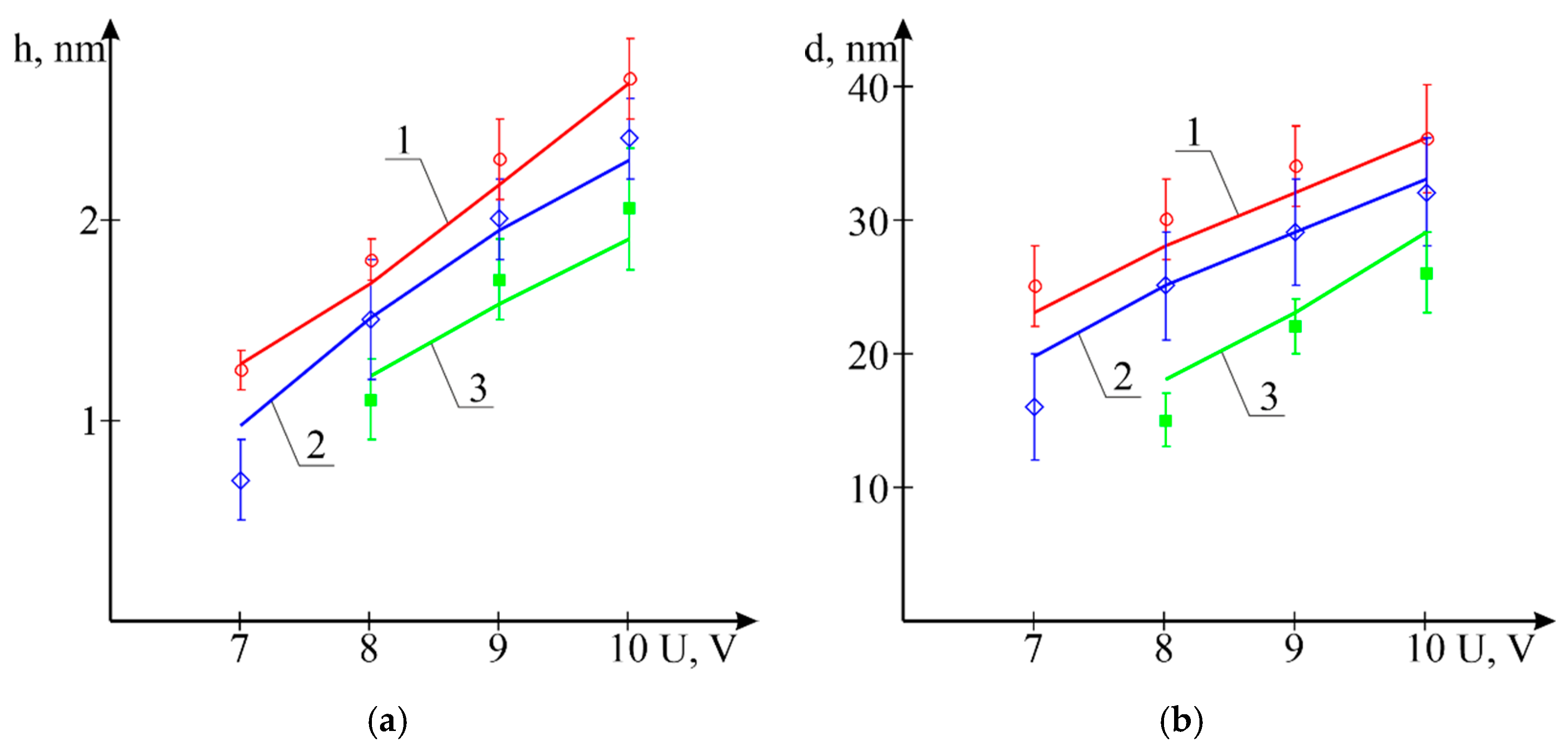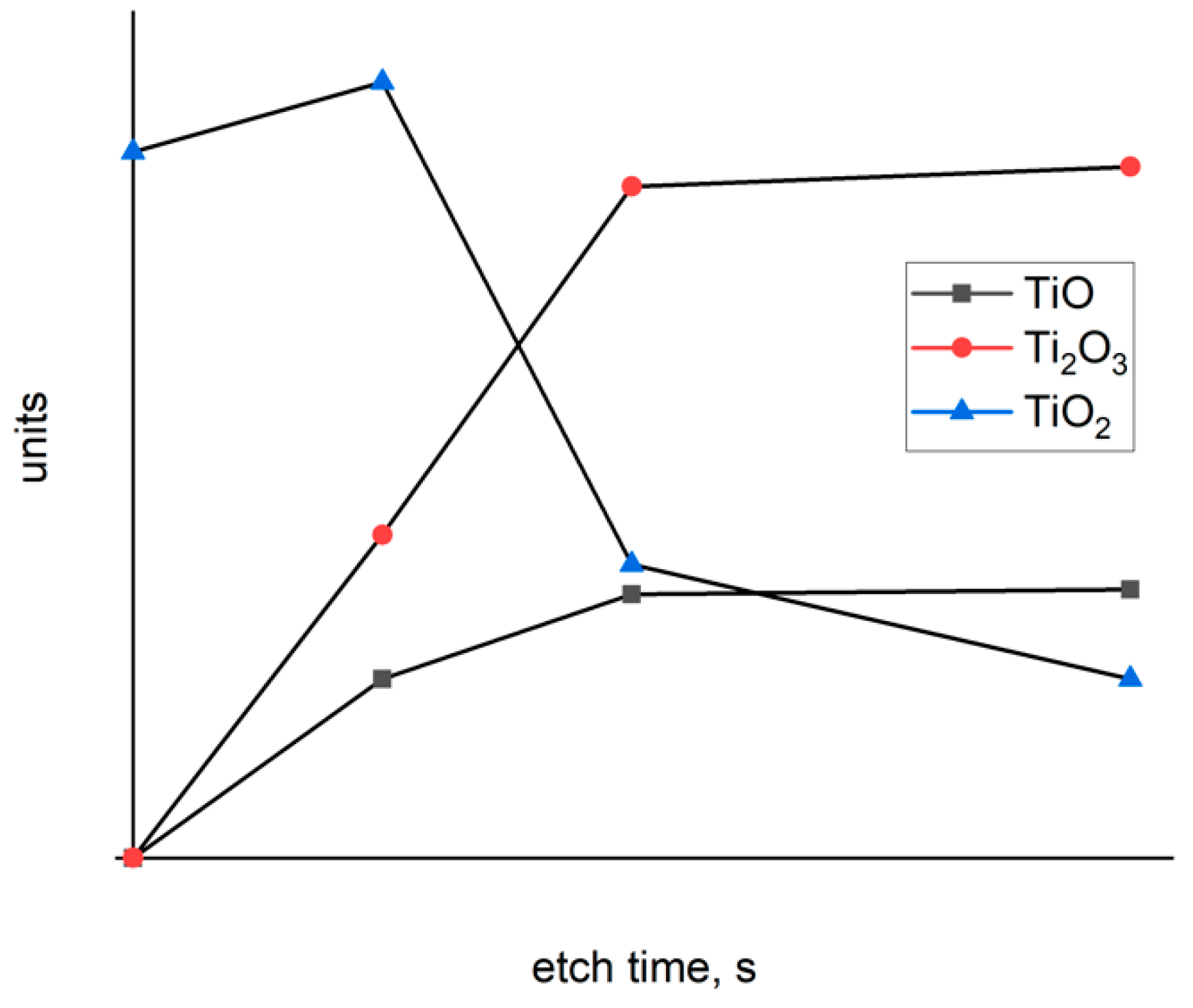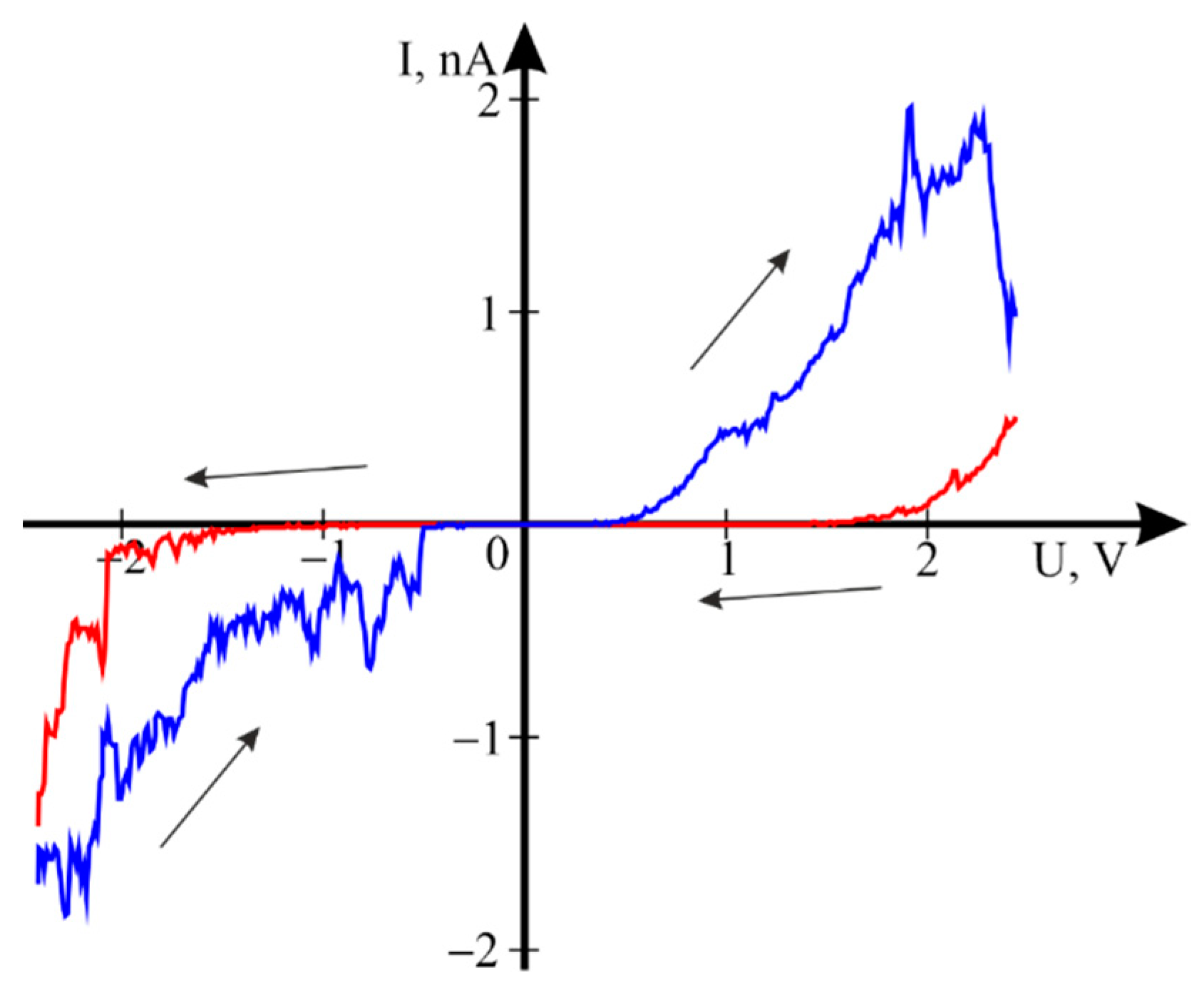Formation, Phase Composition and Memristive Properties of Titanium Oxide Nanodots †
Abstract
:1. Introduction
2. Methods
3. Results and Discussion
4. Conclusions
Funding
Institutional Review Board Statement
Informed Consent Statement
Data Availability Statement
References
- Jaiswal, A.; Chakraborty, I.; Agrawal, A.; Roy, K. 8T SRAM cell as a multibit dot-product engine for beyond von neumann computing. IEEE Trans. Very Large Scale Integr. (VLSI) Syst. 2019, 27, 2556–2567. [Google Scholar] [CrossRef]
- Smith, L.S. Neuromorphic systems: Past, present and future. Brain Inspired Cogn. Syst. 2008, 1, 167–182. [Google Scholar]
- Jo, S.H.; Chang, T.; Ebong, I.; Bhadviya, B.B.; Mazumder, P.; Lu, W. Nanoscale memristor device as synapse in neuromorphic systems. Nano Lett. 2010, 10, 1297–1301. [Google Scholar] [CrossRef] [PubMed]
- Prezioso, M.; Merrikh-Bayat, F.; Hoskins, B.D.; Adam, G.C.; Likharev, K.K.; Strukov, D.B. Training and operation of an integrated neuromorphic network based on metal-oxide memristors. Nature 2015, 521, 61. [Google Scholar] [CrossRef] [PubMed]
- Avilov, V.I.; Smirnov, V.A.; Fedotov, A.A.; Tominov, R.V.; Sharapov, N.A.; Polupanov, N.A. Formation of memristor nanostructures for RRAM memory by local anodic oxidation. IOP Conf. Ser. Mater. Sci. Eng. 2018, 443, 012004. [Google Scholar] [CrossRef]
- Xie, L.; Du Nguyen, H.A.; Taouil, M.; Hamdioui, S.; Bertels, K. A Mapping Methodology of Boolean Logic Circuits on Memristor Crossbar. Aided Des. Integr. Circuits Syst. 2018, 37, 311–323. [Google Scholar] [CrossRef]
- Bousoulas, P.; Giannopoulos, J.; Giannakopoulos, K.; Dimitrakis, P.; Tsoukalas, D. Memory programming of TiO2−x films by Conductive Atomic Force Microscopy evidencing filamentary resistive switching. Appl. Surf. Sci. 2015, 32, 55–61. [Google Scholar] [CrossRef]
- Lu, W.; Wong, L.M.; Wang, S.; Zeng, K. Probing electrochemically induced resistive switching of TiO2 using SPM techniques. Phys. Chem. 2017, 19, 31399–31409. [Google Scholar]
- Avilov, V.I.; Kolomiytsev, A.S.; Tominov, R.V.; Alyabyeva, N.I.; Bykova, E.M. Investigation of the electrode material influence on the titanium oxide nanosize structures memristor effect. IOP Conf. Ser. J. Phys. Conf. Ser. 2018, 1124, 022019. [Google Scholar] [CrossRef]
- Avilov, V.I.; Tominov, R.V.; Sharapov, N.A.; Smirnov, V.A.; Ageev, O.A. Local Anodic Oxidation Proceses Influence and Temterature Stability on the Memristive Propherties of Titanium Oxide Nanostructures for ReRAM Development Moscow Workshop on Electronic and Networking Technologies. In Proceedings of the 2020 Moscow Workshop on Electronic and Networking Technologies (MWENT), Moscow, Russia, 11–13 March 2020; p. 9067405. [Google Scholar]




Publisher’s Note: MDPI stays neutral with regard to jurisdictional claims in published maps and institutional affiliations. |
© 2021 by the authors. Licensee MDPI, Basel, Switzerland. This article is an open access article distributed under the terms and conditions of the Creative Commons Attribution (CC BY) license (https://creativecommons.org/licenses/by/4.0/).
Share and Cite
Avilov, V.I.; Tominov, R.V.; Suharevich, D.A.; Ugrumov, I.S.; Solodovnik, M.S.; Smirnov, V.A.; Ageev, O.A. Formation, Phase Composition and Memristive Properties of Titanium Oxide Nanodots. Mater. Proc. 2021, 4, 44. https://doi.org/10.3390/IOCN2020-07848
Avilov VI, Tominov RV, Suharevich DA, Ugrumov IS, Solodovnik MS, Smirnov VA, Ageev OA. Formation, Phase Composition and Memristive Properties of Titanium Oxide Nanodots. Materials Proceedings. 2021; 4(1):44. https://doi.org/10.3390/IOCN2020-07848
Chicago/Turabian StyleAvilov, Vadim I., Roman V. Tominov, Denis A. Suharevich, Ivan S. Ugrumov, Maksim S. Solodovnik, Vladimir A. Smirnov, and Oleg A. Ageev. 2021. "Formation, Phase Composition and Memristive Properties of Titanium Oxide Nanodots" Materials Proceedings 4, no. 1: 44. https://doi.org/10.3390/IOCN2020-07848
APA StyleAvilov, V. I., Tominov, R. V., Suharevich, D. A., Ugrumov, I. S., Solodovnik, M. S., Smirnov, V. A., & Ageev, O. A. (2021). Formation, Phase Composition and Memristive Properties of Titanium Oxide Nanodots. Materials Proceedings, 4(1), 44. https://doi.org/10.3390/IOCN2020-07848








